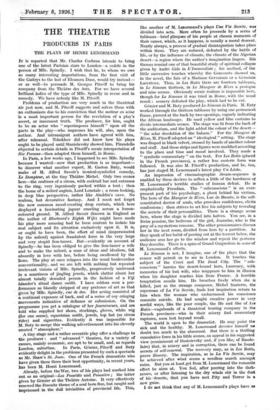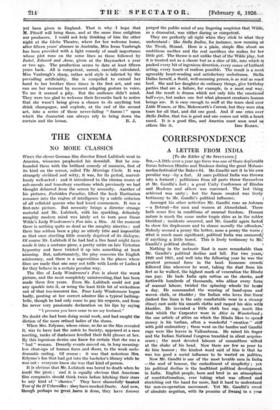THE THEATRE
PRODUCERS IN PARIS
THE PLAYS OF HENRI LENORMAND
IT is reported that Mr. Charles Cochran intends to bring one of the latest Parisian stars to London—a vedette in the person of Mlle. Spinelly. I wish that he, to whom we owe so many interesting importations, from the first visit of the Guitrys to the last of Eleanora Duse, would try instead— or as well—to persuade M. Georges Pitoeff to bring his company from the Theatre des Arts. For we have several brilliant ladies of the type of Mlle. Spinelly in revue and in comedy. We have nobody like M. Pitoeff.
' Problems of production are very much in the theatrical air just now, and M. Pitoeff suggests and solves them with an enthusiasm due to his conviction that the metteur en scene is a most important person for the revelation of a play's secret, or innermost truth. The producer, for him, ought to be an actor who " superimposes himself " upon all the parts in the play—who impresses his will, also, upon the _author. And intransigent authors have agreed with him, after rehearsal. Tchekhov did not know how his plays ought to be played until Stanislaysky showed him. Pirandello objected to certain details in Pitoeff's scenic interpretation of Biz Persons—then adapted them himself, in Rome.
In Paris, a few weeks ago, I happened to see Mlle. Spinelly because I wanted—now that production is so important— to discover what another expert, M. Gaston Baty, would make of M. Alfred Savoir's ironical-symbolist comedy, Is Dompteur, at the tiny Theatre Michel. Only two scenes here—the coulisses of a circus, with cocktail bar and entrance ;to the ring, very ingeniously packed within a tent ; then the home of a milord anglais, Lord Lonstale ; a room looking, in deep blue perspective, rather like Aladdin's cave. No realism, but decorative fantasy. And I must not forget the now common mood-creating drop curtain, which here (iisplayed a fascinating jaguar crawling across a lemon- -coloured ground. M. Alfred Savoir (known in England as the author of Bluebeard's Eighth Wife) might have made his play more amusing had he been content to isolate his 'real subject and fix attention exclusively upon it. It is, or ought to have been, the effort of mind (impersonated by the milord) against fraudulent force in the very large and very stupid lion-tamer. But—evidently on account of Spinelly—he has been obliged to give the lion-tamer a wife and to make the milord, a man of ideas and idealism, fall absurdly in love with her, before being swallowed by the lions. The play at once relapses into the usual boulevardier conventionality, and we are left with nothing but repeated irrelevant visions of Mlle. Spindly, progressively undressed in a scantiness of jingling jewels, which clatter about her almost totally denuded person in the fashion of a Fiji islander's ritual dance outfit. I have seldom seen a per- lormance so blandly stripped of any pretence of art as that given by Mlle. Spinelly, vue de dos. Her acting consisted of
a continual exposure of back, and of a series of coy cringing movements indicative of defiance or submission. On the
programme you get a catalogue of her fournisseurs, and are told who supplied her shoes, stockings, gloves, white wig (for one scene), equestrian outfit, jewels, top hat (as circus rider) and cigarettes. Evidently it was impossible for 31. Baty to merge this walking advertisement into his cleverly created " atmosphere."
A tiny stage and a rather eccentric play offer a challenge to the producer : and " advanced " theatres, for a variety of causes, mainly economic, are apt to be small, and, as regards London, suburban. In Paris, Gemier, .Pitoeff and Baty evidently delight in the problems presented by such a spectacle as Mr. Shaw's St. Joan. One of the French dramatists who have given these three their best opportunity, in recent years, has been M. Henri Lenormand.
Already, before the War, two of his plays had marked him out as an original—Les Possedes and Poussiere ; the latter given by Gemier at the Theatre Antoine. It very effectively renewed the Ibsenite theme of a soul born free, but caught and imprisoned in the dull trivialities of provincial life. This, Me another of M. Laiormand's plays Une Vie Secrete, was divided into acts. More often he proceeds by a series of tableaux—brief glimpses of his people at chosen moments of their career, which, as it happens, is usually a moral descent. Nearly always, a process of gradual disintegration takes place within them. They are reduced, defeated by the battle of life, or by the influence of climate, the climate of the Algerian desert—a region where the author's imagination lingers. His themes remind one of that beautiful study of spiritual collapse given by Andre Gide in L'Immoraliste ; his method, of the little successive touches whereby the Goncourts showed us, in the novel, the fate of a Madame Gervaisais or a Germinie Lacerteux. Thus, in Les Rates there are fourteen tableaux, in Le Simoun thirteen, in Le Mangeur de Rives a prologue and nine scenes. Obviously scenic realism is impossible here, though for Le Simoun it was tried in. Rome, with the usual result : scenery defeated the play, which had to be cut.
Gemier and M. Baty produced Le Simoun in Paris. M. Baty worked through the thirteen tableaux by using one permanent frame, pierced at the back by two openings, vaguely indicating the African landscape. He used yellow and blue curtains to divide intermediate scenes. The stage was lit from the back of the auditorium, and the light added the colour of the desert- " the solar desolation of the Sahara." For the Mangeur de Rives, M. Pitoeff adopted an " ideological" setting. The stage was draped in black velvet, crossed by bands of another colour and stuff. And these strips and figures were modified according to the place and time and mood involved. They made a " symbolic commentary " on the text. For Les Rates (placed in the French provinces), a rather less esoteric form was followed. It was also M. Pitoeff's production, and he, too, has just staged M. Lenormand's latest play Un Ldche.
An impression of cinematographic dream-sequence is enabled by these devices to soften a little of the harshness of M. Lenormand's terrible studies of human defeat. He is emphatically Freudian. The " subconscious " is an ever- present part of his psychology, a ghost behind his victims. The hero of the Mangeur de Rives, Luc de Bronte, is the self- constituted doctor of souls, who provokes confidences, elicits confessions ; then strives to set free his subjects by revealing the secrets of their personalities. There is a strange scene here, where the stage is divided into halves. You see, in a Swiss pension, the bedroom of the girl, Jeannine, who is the prey of a mysterious remorse. The other pensionnaires discuss her in the next room, divided from hers by a partition. As they speak of her habit of peering out at the torrent below, the audience sees her go to the window and repeat the gestures they describe. There is a spice of Grand Guignolism in some of M. Lenormand's effects.
Le Simoun is not, I imagine, one of the plays that the censor will permit us to see in London. It touches the subject of the Cenci and The Dead City. The " sub- conscious " harries the desert-bound hero, Laurency, with memories of his lost wife, who reappears to him in illusion when his daughter reaches him from France. A horrible temptation assails him. He breathes freely when she is killed, just as the strange composer, Michel Sauterre, the superman of La Vie Secrete, finds lost inspiration return to him when the woman who embarrassed his conscience commits suicide. He had sought creative power in very sordid ways, like the poor couple, the He and She of Les Rates—vagabonds of a theatrical touring company in the French provinces—who in their misery find momentary raptures, soon lost beyond recall.
The world is open to the dramatist. He may paint the sick and the healthy. M. Lenormand devotes himself no doubt too much to the abnormal. But there is a thrilling cumulative force in his little scenes, an appeal in his suggested view (reminiscent of Dostoievsky and, if you like, of Boucle- /sire) that, in misery and in corruption, there can be found secrets of self-renewal. The recovery may, as in Les Rates, prove illusory. The inspiration, as in La Vie Secrete, may be achieved after what seems a needless search amongst ruins. But you at least get from M. Lenormand the romantic effect he aims at. You feel, after peering into the dark- nesses, or after listening to the dry winds stir in the dust of his • deserts, that you have met Pity and Terror in a new guise.
I do not think that any of M. Lenormand's plays have as
yet been given in England. That is. why..I hope that. M. Pitoeff will bring them, and at the . same time .enlighten our producers. I could not help thinking of him the other night at the Globe Theatre, where for her welcome home, after fifteen years' absence in Australia, Miss Irene Vanbrugh has been provided with a light comedy of small importance whose plot runs on the same lines as those followed by Isabel, Edward and Anne, given at the Haymarket a year or two ago. The production seems to date at least fifteen years back. All is competent, unreal, carefully calculated. Miss Vanbrugh's sharp, rather acid style is infected by the prevailing artificiality. She is compelled to extend her hand to her brother three times in the first act, and one can see her moment by moment adapting gesture to voice. To me it seemed a pity. But the audience didn't mind. They were too glad to welcome their favourite back to notice that she wasn't being given a chance to do anything but drink champagne, and explode, at the end of the second act, into a series of those never-failing " damns 1" upon which the dramatist can always rely to bring down the



























































 Previous page
Previous page